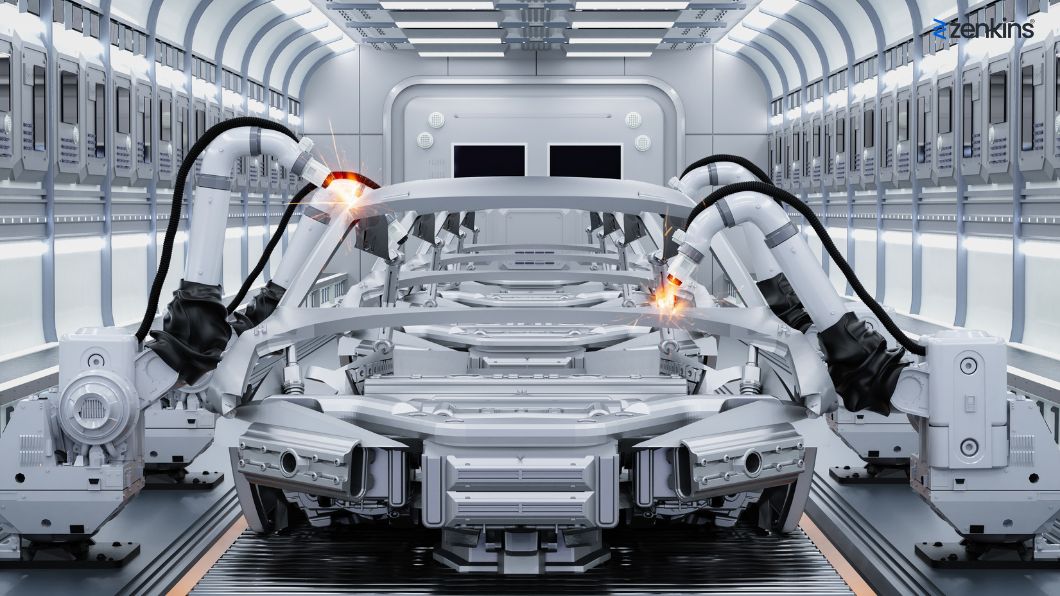Driving Innovation: AI Applications in the Automotive Industry
Table of Contents
The automotive industry is undergoing a remarkable transformation thanks to the integration of Artificial Intelligence (AI) technologies. From enhancing vehicle safety to revolutionizing autonomous driving, AI applications are driving innovation and reshaping the future of mobility. This article explores the significant role that AI plays in the automotive sector and its potential to transform various aspects of the industry. By leveraging AI algorithms, sensing technologies, and predictive analytics, car manufacturers are pushing the boundaries of what vehicles can do.
Moreover, AI-enabled in-car infotainment systems and virtual assistants are providing personalized and immersive driving experiences. However, the adoption of AI in the automotive industry also brings forth ethical and regulatory challenges that must be carefully addressed. As we delve into the various applications and implications of AI in the automotive industry, we gain valuable insights into how AI is shaping the future of transportation and mobility.
Introduction: The Role of Artificial Intelligence in Driving Innovation in the Automotive Industry
The Evolution of AI in the Automotive Industry
Artificial intelligence (AI) has become a game-changer in the automotive industry, helping to drive innovation and shape the future of transportation. Over the years, AI has evolved from a concept confined to science fiction movies to becoming an integral part of our daily lives, including our cars. From voice assistants like Siri and Alexa to self-parking vehicles, AI has made remarkable progress in the automotive sector.
Benefits and Opportunities of AI in Automotive
The integration of AI in automobiles brings forth numerous benefits and opportunities. One of the most significant advantages is enhanced safety. AI-powered systems can assist drivers in avoiding collisions, alert them to potential hazards, and even take control of the vehicle in emergency situations. Additionally, AI algorithms enable autonomous vehicles to navigate complex road conditions, making transportation more efficient and reducing traffic congestion. Moreover, AI-driven robotics and predictive analytics optimize manufacturing processes and streamline supply chain management in the automotive industry.
Enhancing Vehicle Safety: AI-powered Advanced Driver Assistance Systems (ADAS)
Overview of ADAS Technology
Advanced Driver Assistance Systems (ADAS) rely on AI algorithms to provide additional safety measures for drivers. These systems use a combination of sensors, cameras, and data processing to detect and respond to potential collisions or deviations from the intended path. ADAS technology has evolved to include features such as adaptive cruise control, automatic emergency braking, and blind-spot detection, all aimed at preventing accidents and reducing the severity of collisions.
AI Applications in ADAS: Collision Avoidance Systems
AI plays a crucial role in collision avoidance systems, one of the key components of ADAS. By analyzing data from surrounding sensors, AI algorithms can detect potential hazards on the road, such as pedestrians or other vehicles. These systems then alert the driver or autonomously apply the brakes to prevent a collision. With AI’s ability to process vast amounts of data in real-time, collision avoidance systems have become more accurate and reliable, significantly improving vehicle safety.
AI Applications in ADAS: Lane Departure Warning Systems
Lane Departure Warning Systems (LDWS) utilize AI algorithms and cameras to monitor the vehicle’s position on the road. By analyzing lane markings, LDWS can determine if the vehicle is drifting out of its lane without signaling. If such a deviation occurs, the system provides a visual, auditory, or haptic warning to alert the driver. AI enables these systems to accurately interpret the road markings and distinguish between intentional lane changes and unintended drifting, promoting safer driving habits.
Revolutionizing Autonomous Driving: AI Algorithms and Sensing Technologies
The Advancements in Autonomous Driving Technology
Autonomous driving represents the pinnacle of AI integration in the automotive industry. It involves AI algorithms and sensing technologies to enable vehicles to navigate and operate without human intervention. Advancements in AI have allowed autonomous vehicles to perceive, analyze, and respond to their environment, making significant strides towards achieving fully self-driving cars.
AI Algorithms for Autonomous Decision Making
AI algorithms are the driving force behind autonomous decision making. These algorithms process real-time data from sensors, such as lidar, radar, and cameras, to make informed decisions on navigation, speed, and interactions with other vehicles and pedestrians. With continuous learning capabilities, AI algorithms can adapt and improve their decision-making processes over time, resulting in safer and more efficient autonomous driving.
Sensing Technologies for Autonomous Vehicles
Sensing technologies play a critical role in autonomous vehicles by providing a comprehensive view of the vehicle’s surroundings. Lidar, radar, and cameras work together to detect and identify objects, assess their distance and velocity, and create a detailed map of the environment. These sensors, coupled with AI algorithms, enable autonomous vehicles to navigate complex traffic scenarios, making autonomous driving a tangible reality.
Optimizing Manufacturing and Supply Chain: AI-driven Robotics and Predictive Analytics
The Role of AI in Automotive Manufacturing Processes
AI has transformed automotive manufacturing processes by introducing advanced robotics and automation. AI-driven robots are capable of performing repetitive tasks with precision and speed, enhancing productivity and reducing human errors. Additionally, AI algorithms analyze data from production lines to identify bottlenecks, optimize workflows, and improve overall efficiency in manufacturing operations.
AI-driven Robotics in Assembly Lines
Collaborative robots, or “cobots,” equipped with AI capabilities, have become valuable assets in automotive assembly lines. These robots work alongside human workers, assisting them with tasks that require strength or precision. AI algorithms enable cobots to learn from human input, adapt to changing circumstances, and safely collaborate with their human counterparts, resulting in more efficient and flexible manufacturing processes.
AI and Predictive Analytics in Supply Chain Management
AI and predictive analytics have revolutionized supply chain management in the automotive industry. By analyzing vast amounts of data, AI algorithms can predict demand, optimize inventory levels, and identify potential disruptions in the supply chain. This proactive approach helps manufacturers streamline their operations, reduce costs, and ensure timely delivery of components and vehicles, ultimately improving customer satisfaction.
Personalized Driving Experience: AI-enabled In-car Infotainment and Virtual Assistants
AI-powered In-car Infotainment Systems
Gone are the days when car radios were the pinnacle of in-car entertainment. With AI-powered infotainment systems, driving becomes an immersive experience. These systems analyze user preferences and behavior to deliver personalized content, whether it’s music, news, or podcasts. By leveraging machine learning algorithms, AI-infused infotainment systems learn and adapt to the driver’s preferences over time, making every journey a tailored experience.
Virtual Assistants for Enhanced Driving Experience
Virtual assistants, like the popular Alexa and Google Assistant, have found their way into cars as well. These intelligent companions make driving safer and more convenient by allowing hands-free control over various functions. Need directions? Just ask your virtual assistant. Want to change the temperature or make a phone call? Simply speak your command. These virtual assistants provide a seamless and intuitive interaction, ensuring a safer and more enjoyable driving experience.
Personalization and Customization Features
AI-driven technology brings personalization and customization features to a whole new level. From adjusting seat positions and temperature preferences to creating individualized driver profiles, AI allows each person in the car to have their preferences met automatically. This level of personalization not only enhances comfort but also contributes to safety, as the vehicle can adapt to each driver’s unique needs and habits.
Transforming Maintenance and Service: AI-based Predictive Maintenance and Diagnostics
The Role of AI in Automotive Maintenance
AI is revolutionizing how automotive maintenance is approached. Instead of relying on scheduled maintenance, AI-powered systems monitor the vehicle’s condition in real-time, detecting anomalies and potential issues. This proactive approach to maintenance helps prevent breakdowns and reduces the risk of costly repairs.
AI-driven Predictive Maintenance Technology
By analyzing data from various sensors and systems, AI can predict when a component is likely to fail and schedule maintenance accordingly. This predictive maintenance approach optimizes vehicle availability and minimizes downtime, especially in commercial fleets. AI algorithms can also identify patterns and trends in maintenance data, leading to improved reliability and cost-efficiency.
AI-powered Diagnostics for Efficient Repairs
When something does go wrong with a vehicle, AI-powered diagnostics enable efficient repairs. By integrating with the vehicle’s onboard systems, AI algorithms can quickly identify the root cause of an issue and provide detailed diagnostic information to mechanics. This speeds up the repair process, reduces guesswork, and ensures accurate and effective repairs.
Ethical and Regulatory Challenges: Navigating the Intersection of AI and Automotive Industry
The Ethical Considerations of AI in Automotive
With great power comes great responsibility, and AI in the automotive industry is no exception. Ethical considerations arise when AI systems make critical decisions that affect human lives, such as autonomous driving. Questions of accountability, transparency, and the potential for bias must be addressed to ensure the safe and fair deployment of AI technologies in vehicles.
Regulatory Frameworks and Standards for AI-driven Vehicles
To navigate the complex intersection of AI and the automotive industry, regulatory frameworks and standards are crucial. Governments and industry organizations are working to establish guidelines and regulations that ensure the safe and ethical use of AI in vehicles. These frameworks cover areas such as data privacy, cybersecurity, and liability, aiming to create a harmonized and responsible AI-driven automotive landscape.
Addressing Privacy and Security Concerns
The integration of AI in vehicles raises concerns about privacy and cybersecurity. AI systems collect and process vast amounts of data, including personal information. Safeguarding this data and ensuring secure communication between vehicles and infrastructure is paramount. Stricter data protection measures and robust cybersecurity protocols must be put in place to protect both drivers and their vehicles from potential threats.
Future Outlook: Exploring the Potential of AI in Shaping the Future of Mobility
AI and the Future of Electric and Connected Vehicles
AI is set to play a vital role in shaping the future of electric and connected vehicles. By optimizing energy consumption, AI algorithms can enhance the range and efficiency of electric vehicles. Furthermore, AI enables seamless integration with connected infrastructure, allowing vehicles to communicate with traffic systems, other vehicles, and pedestrians. This connectivity opens up possibilities for efficient traffic management, safer roads, and enhanced mobility for all.
AI’s Impact on Urban Mobility and Transportation Infrastructure
Urban areas face unique mobility challenges, but AI offers solutions. AI algorithms can analyze traffic patterns, predict congestion, and optimize route planning to reduce travel time and improve urban mobility. Additionally, AI can support smart city initiatives by enabling intelligent transportation systems that monitor and manage traffic flow, parking availability, and public transit. This integration of AI into transportation infrastructure has the potential to transform cities into more sustainable, efficient, and livable environments.
With AI driving innovation in the automotive industry, the future of mobility promises not only personalized experiences and improved maintenance but also ethical guidelines, enhanced security, and a transformed urban landscape. As technology continues to advance, the intersection of AI and automotive industry holds great promise in shaping a safer, smarter, and more enjoyable driving experience for all.
Conclusion
In conclusion, the integration of Artificial Intelligence in the automotive industry is driving innovation and revolutionizing the way we think about transportation. From enhancing safety to optimizing manufacturing processes, AI applications are transforming every aspect of the automotive sector. As we continue to explore the potential of AI in shaping the future of mobility, it is crucial to address ethical and regulatory concerns to ensure the responsible and safe implementation of these technologies. With AI-powered advancements, we can look forward to a future of smarter, safer, and more efficient vehicles that provide personalized driving experiences.
As the automotive industry embraces AI, it opens up new possibilities for a connected and autonomous future, paving the way for a transformative era of transportation.
AI has become a driving force in the automotive industry, fueling innovation and transforming the way we drive and manufacture vehicles. From enhancing vehicle safety through ADAS to revolutionizing autonomous driving and optimizing manufacturing processes, the integration of AI has opened up new possibilities and paved the way for a more connected and intelligent automotive future.
FAQ
How is Artificial Intelligence (AI) enhancing vehicle safety in the automotive industry?
AI is enhancing vehicle safety through the integration of advanced driver assistance systems (ADAS). These systems, powered by AI algorithms, utilize technologies such as collision avoidance systems and lane departure warning systems to assist drivers in avoiding potential accidents and maintaining safe driving conditions.
What role does AI play in autonomous driving?
AI plays a crucial role in autonomous driving by enabling vehicles to make intelligent decisions and navigate their surroundings without human intervention. AI algorithms and sensing technologies are used to interpret and process data from various sensors, such as cameras and radar, allowing autonomous vehicles to perceive their environment and make informed decisions in real-time.
How is AI transforming the manufacturing and supply chain processes in the automotive industry?
AI is transforming manufacturing and supply chain processes by leveraging robotics and predictive analytics. AI-driven robotics automate tasks in assembly lines, increasing efficiency and accuracy. Predictive analytics, powered by AI, analyze large datasets to optimize production planning, inventory management, and supply chain logistics, resulting in improved productivity and cost savings.
What are the ethical and regulatory challenges associated with AI in the automotive industry?
The adoption of AI in the automotive industry raises ethical and regulatory challenges. These include concerns about the accountability and liability of autonomous vehicles in the event of accidents, the ethical implications of vehicle decision-making algorithms, and the need for robust data privacy and cybersecurity measures. Regulatory frameworks and industry standards are being developed to address these challenges and ensure the responsible deployment of AI technologies in the automotive sector.




